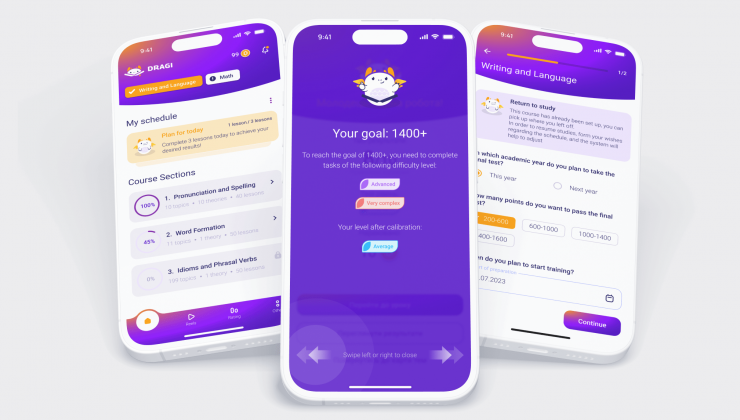How can we know that it’s time to implement a Learning Management System? It’s actually quite simple. If you want to:
- systematize employee training, improve its quality and efficiency;
- reduce expenses on business trips, venue rentals, and external trainers;
- retain knowledge within the company even when employees leave;
- receive analytics and progress reports to make informed management decisions and enhance talent development;
- streamline and accelerate the onboarding of new hires.
If at least one of these points resonates with you, then adopting an LMS isn’t just helpful - it’s essential for your business.
Let’s dive into what to look for in a Learning Management System and share practical advice on implementing and leveraging such a platform.
What Is a Learning Management System?
A Modern Learning Management System (LMS) is a digital platform designed to organize, conduct, and monitor educational processes. It allows you to create courses, manage training materials, track learner progress, and analyze performance data.
Essentially, LMS functionality replaces outdated corporate training methods like traditional seminars, workshops, and senior-to-junior mentorships. It’s a modern, interactive, and far more engaging way to gain knowledge.
LMS for Different User Segments

One of the strongest LMS capabilities is flexibility. LMS solutions adapt to the needs of various organizations. While this article focuses on corporate applications, it’s important to note that LMS platforms are widely used across sectors:
- LMS software for schools, universities, and online academies: Learning Management System features let instructors to create interactive courses, assign homework, grade assignments, and communicate with students - all within a single interface.
- Students: They gain 24/7 access to materials, complete assessments, monitor their progress, and learn at their own pace, making remote education not just possible but highly effective.
- Nonprofits: LMS features help scale training programs for volunteers and staff without extra costs: one online course available globally replaces repetitive in-person meetings.
- Government agencies: LMS platforms support employee upskilling, regulatory compliance training, and mass education initiatives, offering a cost-effective, transparent, and scalable solution.
Finally, in the corporate world, LMS education software delivers clear strategic value: time is money, and a well-trained workforce is a competitive edge.

Companies can onboard new hires faster, refresh employee knowledge regularly, assign training by roles, track results, and promote a culture of continuous growth, even across distributed teams.
As you can see, a student Learning Management System is a universal tool for transformation. And “students” might include a 35-year-old IT project manager upskilling in Agile and DevOps, or a 60-year-old doctor learning new medical protocols via a corporate LMS.
Key Features of Learning Management Systems

Benjamin Franklin once said, “An investment in knowledge pays the best interest”. That’s why it’s crucial to understand the features of a Learning Management System.
This isn’t just buying another IT solution, it’s investing in the resilience and future success of your organization. Knowing which components are essential helps you choose the right system and avoid unnecessary costs.
Depending on your needs, some LMS platforms excel at mass online education, others specialize in corporate onboarding, and some are perfect for hybrid learning.
What makes a good Learning Management System? While specifics vary, these universal traits define quality:
Intuitive interface: Like they use it in Google Classroom. LMS features can be incredible. If users can’t navigate without a manual, they simply won’t use the platform. Noone wants to study more for studying.
Customization flexibility: Adapt the platform to match your internal structure.
Rich content support: Videos, quizzes, surveys, presentations, SCORM compatibility - engaging content prevents boredom.
Analytics and reporting: course management system software (progress, performance, engagement detailed statistics) are non-negotiable.
Mobile accessibility: Mobile-friendly Learning Management System products ensure learners can study anywhere, anytime. At the very least, the platform should be adapted not only for desktop computers but also for tablets and smartphones. It is crucial for learners to have their training materials readily accessible at all times, whether they are in the office, at home, or on the go.
Integration capabilities: The Learning Management System for students and employees should easily connect with CRM, HRM, Zoom, Slack, and more.
Data security: Especially critical for government and corporate deployments.
Next, let's break down the 10 key features of LMS you should focus on to streamline implementation and maximize outcomes.
1. User Management and Access Control
In any example of a Learning Management System in education, users aren’t just login IDs - they are employees, instructors, students, and partners. Each user has specific roles, permissions, and a personalized “entry point” into the system.
Features of a good LMS focus on clearly defining who sees what, who can access what, and what actions they are allowed to perform.
Imagine if every employee could see everyone else’s learning results. It could easily lead to unhealthy competition, motivation loss, conflicts, and even staff turnover.
Practical tips:
- Predefine typical roles to avoid manual access setup each time.
- Automate course assignments by groups (e.g., onboarding courses for new hires).
- Enable Single Sign-On (SSO) if your organization already uses corporate accounts - it simplifies login and strengthens security.
2. Course Creation and Content Management
This is the heart of all Learning Management System features and benefits. Course creation shouldn’t feel like a software development project. It should be an intuitive process for instructional designers, HR specialists, or educators.
Everything should be simple: add a title, insert a video, attach a quiz, click save. Done! Quick, logical, visual, these are key qualities of a good LMS.
Practical tips:
- Use multimedia formats to increase engagement: mix video lessons, infographics, and interactive tasks.
- Build modular courses: design each course like building blocks, making updates easy without rebuilding the entire structure.
- Take advantage of built-in editors: most simple LMS systems offer user-friendly tools requiring no technical expertise.
- Set up sequential course progression: unlock new modules only after completing previous ones to maintain learning flow.
3. Assessment, Testing, and Certification
This is one of the main LMS software features because it shows results. A good platform turns assessment into a smart tool, not just a checkbox, but a clear picture of knowledge retention and knowledge gaps.
Such Learning Management System analytics are critical for organizations with large distributed teams, franchises, or partners where standardized competency levels are vital.
Practical tips:
- Mix question types: making guessing harder and improving knowledge recall.
- Implement gamified quizzes (e.g., weekly challenges with prizes).
- Set up automated certificate templates for different training programs, this saves time and adds official status to the learning.
- Use online testing not just for final exams, but also for regular self-checks - keeping knowledge fresh and identifying development needs.
4. Tracking, Reporting, and Analytics
Best LMS features aren’t just about proving “it works”, they are about improving both interim and final results.
A good LMS gathers and visualizes key metrics: who started a course, time spent per module, where learners struggle, who passed, and who didn’t even open the course.
Practical tips:
- Add to training management system features automatic reminders for users who stall in the middle of a course (completion rates can increase 2–3x).
- Base decisions on data: which courses need revision? Which topics raise the most questions? Who can become an internal expert?
- Implement AI-driven analytics: deep data infrastructure to optimize your Learning Management System can reveal patterns, predict attrition, and suggest personalized learning paths.
5. Communication and Collaboration Tools
A complete Learning Management System should be more than just a place for lessons and quizzes. It should foster communication and collective growth. This is a LMS must-have for engagement, knowledge sharing, and team building.
Typically, systems include chats, forums, comments, and announcements. But you can also integrate popular messaging apps like Microsoft Teams, Telegram, WhatsApp, and support video conferencing and live classrooms.
Practical tips:
- Use group projects requiring presentation of results: building both knowledge and soft skills like communication, argumentation, and teamwork.
- Create a dedicated “Course Questions” channel: reducing support load and improving community engagement.
- Encourage learners to communicate actively, nurturing a sense of live, meaningful learning rather than mechanical task completion.
"In an IT team where everyone can solve problems individually, the real challenge is getting the 'lone wolves' to talk to each other. Because individuals write code, but teams create revolutions. That’s why communication tools are a vital part of our LMS features checklist"
© HR Team at Wezom
6. Mobile and Accessibility Features
We’ve already touched on the importance of mobile apps and responsive design. These LMS tools and features ensure flexibility, convenience, and learning efficiency. Accessibility also refers to compliance with regulations such as ADA (Americans with Disabilities Act) and WCAG (Web Content Accessibility Guidelines).
Note: The Americans with Disabilities Act requires organizations to provide equal access to education and digital services for individuals with disabilities. In the context of LMS platforms, this means systems should be adapted for:
Visually impaired users (screen reader support),
Users with limited motor skills (keyboard navigation without a mouse),
Deaf and hard-of-hearing users (video subtitles and audio transcripts).
Practical tips:
- Optimize not just the functions of the Learning Management System, but the content itself to ensure it's easily consumable.
- Use push notifications to remind learners about new tasks and events.
- Test the LMS across multiple devices to ensure full functionality on computers, tablets, and smartphones.
- Provide offline access: allow users to download training materials and study without an internet connection.
7. Integration and Scalability
These LMS platform features transform a stand-alone system into a powerful, scalable training center that grows alongside your organization.
Your LMS should integrate easily with CRM, HRM, ERP, and BI systems. This creates a unified information ecosystem and significantly increases training efficiency.
Benefits of integration include: automated processes, personalized learning paths, and consolidated analytics.
Practical tips:
- Use APIs for seamless integration with other systems.
- Sync the LMS with your HRM to automatically update employee profiles and training statuses.
- Choose cloud-based solutions: cloud Learning Management System services offer better scalability and accessibility.
- Anticipate future needs when selecting an LMS to avoid costly system replacements during growth.
- Conduct stress tests to verify the platform can handle increased user loads.
Fun fact:
Companies using scalable LMS solutions are 46% more likely to become market leaders and 58% better prepared for future challenges.
8. Security and Compliance
Why is data encryption critical among learning content management system features? Because an LMS stores sensitive information: employee personal data (names, positions, contacts), test results (which may influence career decisions), and, most importantly, internal learning materials (patents, strategies, trade secrets).
An LMS must comply with international and industry standards like ISO/IEC 27001, PCI DSS, GDPR, NIST, and national data protection laws.
Practical tips:
- Implement multi-factor authentication (MFA).
- Design and enforce a clear role-based access model.
- Ensure regular data backups and recovery procedures.
- Increase employee awareness around data security and compliance.
- Keep your LMS updated to protect against new cybersecurity threats.
9. AI-Powered Personalization and Recommendations
Traditional LMS platforms offer the same learning path to everyone. But AI changes the game: advanced Learning Management Systems adapt to each learner like a personal mentor.
AI analyzes user behavior, achievements, and struggles, and based on that, suggests personalized learning paths tailored to individual styles, pace, and difficulty levels.
Examples of AI-powered personalization:
- A marketing specialist gets prioritized access to digital marketing and advertising case studies rather than finance content.
- An employee who fails a sales test is automatically recommended a course focused on their specific weak points.
- A new hire is offered short, gamified lessons, while an experienced manager receives advanced modules with analytics and negotiation simulations.
10. Cloud-Based LMS Software Features
Cloud components of a Learning Management System are especially valued by companies with remote teams, fast-growing businesses, or international presence. Why? Because cloud = freedom.
According to Deloitte, 87% of organizations transitioned to cloud-based learning solutions over the past five years, and over 60% plan to modernize their LMS platforms by the end of 2025.
Practical tips:
- Choose LMS solutions with multi-zone availability if you operate internationally, ensuring fast access for all users.
- Ensure LMS platforms support Single Sign-On (SSO) for streamlined employee access.
- Review SLA (Service Level Agreement for Learning Management System services) carefully: this is crucial for corporate implementations.
Conclusion: Maximizing LMS Potential
What to look for in a Learning Management System?
We always emphasize one primary factor: what do you want to achieve? Is it new employee onboarding, continuous professional development, or selling online courses?
If you’re a startup with 30 remote employees, prioritize a cloud LMS with mobile access.
If you need a Learning Management System in education: focus on SCORM compatibility and modularity.
Choosing the Right LMS Solution should be based on your priority checklist (using the 10 key features described above), user feedback, or your long-term business plans. Choose an LMS not just for today, but for where you’ll be two years from now.
As for Future Trends in LMS Features, one thing is clear: LMS platforms are evolving alongside technology.
Today, AI capabilities are becoming essential:
- Automated course recommendations,
- AI-powered support chatbots,
- Personalized learning trajectories.
Microlearning and mobile-first content are also booming: short modules optimized for smartphones are becoming the new standard.
Additionally, LMS platforms are increasingly integrating with virtual reality (VR) and augmented reality (AR) systems, especially in technical and healthcare training.
Finally, the focus is shifting toward behavioral analytics, not just tracking course completion, but predicting churn, engagement levels, and development needs.
The LMS of the future is no longer just a platform, it's a dynamic ecosystem for personal and professional growth.
Custom LMS Software Development
Why Build a Custom LMS?
Off-the-shelf solutions work “in general”, but they don't reflect your culture, processes, goals, or scale.
A custom LMS, however, fits like a glove, moves at your pace, and grows alongside you. It's not just technology - it's an embodiment of your learning strategy.
Benefits of custom development:
- The platform evolves with your business and easily adapts to new demands.
- Full integration with your internal systems: CRM, HRM, ERP, creating a unified mechanism.
- Unique user experience (UX) aligned with your brand identity, LMS course management and learning goals.
- Full control over security: you decide where and how data is stored and which standards are enforced.
- Long-term cost savings: you pay once for exactly the functionality you need, avoiding ongoing licensing fees.
Now is the best time to develop or upgrade your LMS solution:
Leverage these trends from the beginning, lay a strong foundation for future scalability, and gain a true competitive advantage.
And we are ready to help you design a system that remains relevant not only today but for years to come.


